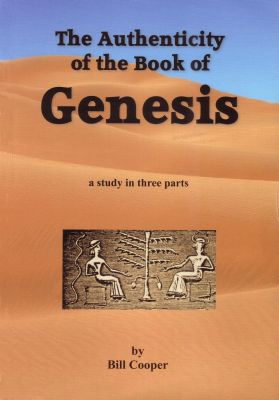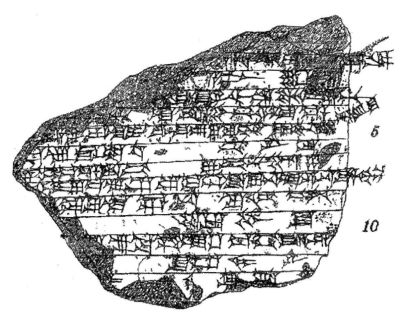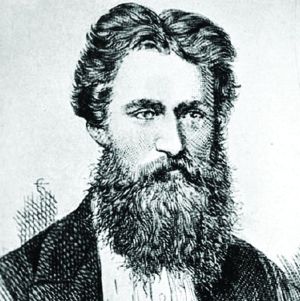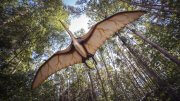Creation Ministries | A review of The Authenticity of the Book of Genesis by Bill Cooper, Creation Science Movement, UK, 2011
Reviewed by Dominic Statham
Bill Cooper is vice-president of the Creation Science Movement in the UK, and a respected historian and scholar. On behalf of the British Library, he transcribed and edited the latest reprint of John Wycliffe’s 1388 translation of the New Testament.1 He has also authored a number of articles and books, including the acclaimed After the Flood,2 in which he documents how the earliest Europeans recorded their descent from Noah. His latest book, The Authenticity of the Book of Genesis, is a veritable feast, with over 400 pages packed with well-documented facts confirming the historicity of the first book of the Bible.
 Archaeologists and students of history know that our museums contain numerous records of the ancient civilizations that lived around the Middle East in the 2½ millennia preceding the birth of Christ. A remarkable number contain narratives that are identical or similar to events documented in Genesis, such as the creation of the world, Adam and Eve, the Flood, and the confusion of languages at Babel. Those who dismiss the Bible as no more than a man-made creation often argue that the authors of Genesis drew upon these pagan sources. Cooper, however, demonstrates that the weight of evidence points to Genesis being the original, authentic record. The many similar accounts from neighbouring tribes, he argues, are clearly corruptions of the true versions witnessed by the patriarchs, and passed down from generation to generation by the descendants of Noah.
Archaeologists and students of history know that our museums contain numerous records of the ancient civilizations that lived around the Middle East in the 2½ millennia preceding the birth of Christ. A remarkable number contain narratives that are identical or similar to events documented in Genesis, such as the creation of the world, Adam and Eve, the Flood, and the confusion of languages at Babel. Those who dismiss the Bible as no more than a man-made creation often argue that the authors of Genesis drew upon these pagan sources. Cooper, however, demonstrates that the weight of evidence points to Genesis being the original, authentic record. The many similar accounts from neighbouring tribes, he argues, are clearly corruptions of the true versions witnessed by the patriarchs, and passed down from generation to generation by the descendants of Noah.
Cooper also documents numerous accounts of creation, a global flood and the confusion of languages found in legends throughout the world. Many of these, again, are remarkably similar to Genesis in their details, indicating a common source and supporting the biblical account of the dispersal of humanity at Babel. Cooper concentrates on the Flood traditions which date from times before any Christian influence could have been the original source.
According to the ‘modernists’ and ‘higher critics’, much of the book of Genesis was compiled during the time of the exile, when the Israelites were held in captivity in Babylon during the 6th century BC. In particular, it’s alleged that the Genesis account of creation is no more than a rehash of the much earlier creation story contained in the Enuma Elish tablets of Babylonia.
As Cooper points out, this is difficult to reconcile with the facts (pp. 22–41). Firstly, the Samaritan copy of the Jewish Pentateuch is written in an ancient form of Hebrew that predates the exile. Secondly, the most ancient Samaritan copy contains over two thousand corruptions of the original Jewish manuscript. These would be expected to accumulate over centuries, making it very unlikely that the Samaritans made their copy soon after the return of the Israelites from Babylon. Indeed, it would seem unlikely that the Samaritans would make a copy of Jewish historical writings at all, given the state of hostility that existed between these two nations around that time.
The Flood
According to many liberal theologians, the Genesis account of the Flood also has its origin in Babylonian myth. In this case, we’re told, the source is the Epic of Gilgamesh. This narrative poem is one of the earliest surviving pieces of literature. It is recorded on clay tablets dating from around the seventh century BC and is thought to be a copy of a much older document, from as early as 1800 BC. Its account of a global flood is strikingly similar to Genesis. For example, it records the wickedness of mankind prior to the deluge, the flooding of the earth by the gods as a divine punishment, the building of an ark by a righteous man, the bringing aboard of selected animals, the destruction of all mankind, the use of birds to monitor the flood’s recession, the ark coming to rest on a mountain and the subsequent offering of a sacrifice.
 Figure 1. Tablet fragment from the Temple Library of the ancient
Figure 1. Tablet fragment from the Temple Library of the ancient
Sumerian city of Nippur (c. 2100 BC). Discovered by the
University of Pennsylvania and translated by Hermann Hilprecht,
its account of the Flood agrees with Genesis in every detail.An alternative explanation for the similarities, of course, is that the epic is one of many records of the Flood that was handed down by Noah’s family to their descendants and retained in the cultures of the burgeoning nations following the scattering of mankind at Babel.
Cooper presents compelling evidence that the modernists’ claim, that the Babylonian Flood legend is the source of all other Flood legends, is false (pp. 386–396). For example, in the last decade of the 19th century, an archaeological dig by the University of Pennsylvania unearthed a tablet fragment from the ancient Babylonian city of Nippur (figure 1). It contains the Flood narrative and, most significantly, is dated to at least 2005 BC—centuries older than the original text of the Gilgamesh epic. It is written in Semitic Babylonian and is therefore closely related to biblical Hebrew. Indeed, its phraseology is so close to the Genesis text that its translator, Professor H.V. Hilprecht, wrote:
“… its significance is further enhanced by the fact that in most important details it agrees with the biblical version of the deluge in a very remarkable manner—much more so than any other cuneiform version previously known” (p. 392).
Unlike the many other Flood stories, it doesn’t depart from the Genesis account in any detail and its clear monotheistic theme is additional evidence that it predates all Flood legends of Babylonian origin. It is arguably one of the most precious discoveries ever for those who seek to defend the Bible from the liberal onslaught, and makes clear that the Epic of Gilgamesh is more reasonably seen to be an independent witness to the truth of the Flood as recorded in the Bible.
Other strong evidence that Gilgamesh is not the original, is the Ark: in Genesis, it is an incredibly sea-worthy vessel that could withstand tsunamis,3 while the Gilgamesh ark is a cube, which would capsize easily. But a cube has only one dimension to remember, and Babylonians lived far from the sea and would not have known of the nautical problems.4,5
Cooper also documents a number of fascinating details which add weight to the modern creationist understanding of the events surrounding the Flood. For example, the Flood legend related by the Benua-Jakun people of the Malay Peninsula refers to the earth as having a skin, under which there is an abyss of subterranean water. The deity, they say, initiated the Flood by breaking up this skin (p. 232). Could this refer to the movements of tectonic plates?6 The Maori account also attributes much of the Flood to geological activity and the rising of subterranean water, and describes the post-Flood earth as being “cracked and fissured in some places” (pp. 253–254). The Tahitian account (pp. 260–261) includes a great falling of stones, which may refer to a meteorite bombardment that many creationists believe took place during the early stages of the Flood.7
The Tower of Babel and the confusion of languages
 Figure 2. The Assyriologist George Smith (1840–1876)
Figure 2. The Assyriologist George Smith (1840–1876)
who first discovered and translated the Epic of Gilgamesh.
Smith was a Bible-believing Christian who worked at the
British Museum. Before he died at the young age of 36,
he had started to inform the public of the many ancient
documents that confirm the historicity of Genesis. As with Flood legends, there is an abundance of testimonies, from all over the world, concerning the building of a great tower and the subsequent confusion of languages at Babel. Among the more ancient accounts is one found in the Sumerian epic, Enmerkar and the Lord of Aratta, thought to be composed around the 21st century BC. It refers to the worship of a chief deity known as ‘Enlil’ and speaks of a time when “the whole universe … to Enlil in one tongue gave praise” (p. 71). Another ancient account is found on a tablet discovered and translated by the Christian Assyriologist George Smith (figure 2) in 1875. A 7th-century-BC copy of an older document, it describes the sin of those who built the tower and how the “father of all the gods” judged them by frustrating their work and confounding their language (pp. 72–73). Similar accounts are related by the Greeks and Romans, including one by Hestiaeus of Perinthus, a pupil of Plato (p. 70).
The Toltecs of Mexico recount how, following the confusion of languages after the building of a great tower, their ancestors lived in caves as they migrated to America (p. 294). Could these have been some of the ‘stone age cavemen’ which evolutionists claim are evidence of primitive human life?8,9,10
The Table of Nations
The Table of Nations (Genesis chs. 10 and 11) documents the descendants of Noah in great detail. It has all the hallmarks of an authoritative and accurate account of the fledgling post-Flood nations as they were born. Cooper testifies,
“I spent more than 25 years digging into the Table of Nations, looking for a fault, an error, a false statement, or an historical inaccuracy. I found not one” (p. 75).11
Needless to say, the modernists understand it to be nothing more than an elaborate work of fiction. A popular view is that it was copied from pagan sources around the 5th century BC, during the ‘Persian period’. This, however, seems most unlikely.
The ‘Persian period’ refers to the time when the Israelites were ruled by the Persians. Rather than being a time when the Jews were treated badly, however, they were shown much favour. Under King Ahasuerus (Xerxes) they enjoyed special protection from their enemies (Esther 8); in the first year of his reign, King Cyrus granted them the freedom to return to Jerusalem and to rebuild the temple, even returning to them the treasure that King Nebuchadnezzar had looted from the original temple (Ezra 1 and 6). The Jews owed the Persians everything. Why, then, if the Table of Nations had been fabricated during this period, does it not even mention Persia? The answer is surely that the Table of Nations was compiled hundreds of years before Persia became known as a nation, i.e. that it predates the Persian Empire. Further confirmation of the authenticity of the Table is evidenced from the absence of other nations known from the Persian Period and from the inclusion of nations that had faded well before the 5th century BC (p. 76).
In Genesis 14, we read of four kings, Amraphel, Arioch, Kedorlaomer, and Tidal, who kidnapped Abraham’s nephew Lot and stole his possessions. All four are mentioned in ancient Mesopotamian tablets now held in the British Museum (pp. 138–145).12
Conclusion
According to the secular, evolutionary history of mankind, people dispersed out of Africa around 60 to 100 thousand years ago. If this were true, we would not expect groups now scattered across the world to have retained the same legends over such a protracted period. Yet corrupted forms of the Genesis account of creation and the early history of mankind are found in numerous cultures, on all the continents, and even among people living on isolated islands, surrounded by thousands of miles of ocean. These facts actually fit the biblical account of history very well. If people dispersed out of the Middle East a little over 4,000 years ago, as the Bible indicates, we would expect the descendants of these people to share common legends.
Cooper has spent much of his life researching the early history of mankind and this has culminated in a most valuable resource. In The Authenticity of the Book of Genesis he piles fact upon fact and argument upon argument confirming that the Bible does, indeed, record the true history of mankind. I shall never read Genesis in the same way again.
SOURCE: CREATION MINISTRIES
Related Articles
- Safety investigation of Noah’s Ark in a seaway
- Noah’s Flood and the Gilgamesh Epic
- A comparative study of the flood accounts in the Gilgamesh Epic and Genesis
Further Reading
- Cave men—in the Bible
- Was Christianity plagiarized from pagan myths?
- How did all the animals fit on Noah’s Ark?
Related Media
- Peter’s prophecy and a global flood
- Noah’s Flood: Key to Understanding the Age of the Earth (Part 1)
References and notes
- Cooper, W. (Ed.), The Wycliffe New Testament 1388: An Edition in Modern Spelling with an Introduction, the Original Prologues and the Epistle to the Laodiceans, British Library Publishing Division, London, 2002. Return to text.
- Cooper, W., After the Flood, New Wine Press, West Sussex, 1995. Return to text.
- Hong, S.W. et al., Safety investigation of Noah’s Ark in a seaway, J. Creation 8(1):26–36, 1994; creation.com/arksafety. Return to text.
- Sarfati, J., Noah’s Flood and the Gilgamesh Epic, Creation 28(4):12–17, 2006; creation.com/gilgamesh. Return to text.
- Osanai, N., A comparative study of the flood accounts in the Gilgamesh Epic and Genesis, M.A. Thesis, Wesley Biblical Seminary, Jackson, MS, 2004; creation.com/gilg. Return to text.
- Batten, D. (Ed.), The Creation Answers Book, 3rd edn, Creation Book Publishers, creationbookpublishers.com, pp. 165–169, 2009. Return to text.
- Oard, M.J., How many impact craters should there be on the earth? J. Creation 23(3):61–69, 2009. Return to text.
- Catchpoole, D., Cave men—in the Bible, Creation 31(3):52–53, June 2009; creation.com/bible-cave-men. Return to text.
- Sarfati, J., Refuting Evolution 2, Creation Book Publishers, creationbookpublishers.com, p. 200, 2011. Return to text.
- Garner, P., The New Creationism, Evangelical Press, Darlington, Durham, p. 231, 2009. Return to text.
- Ref. 2. Return to text.
- British Museum shelf mark numbers Sp. II. 987; Sp. III. 2; Sp. 158 and Sp. II. 962. Return to text.




